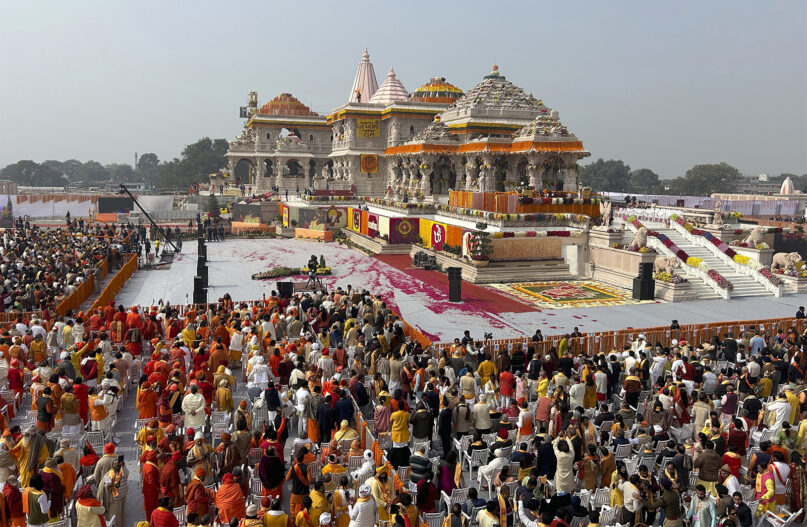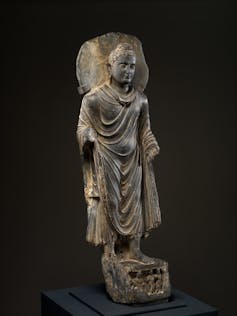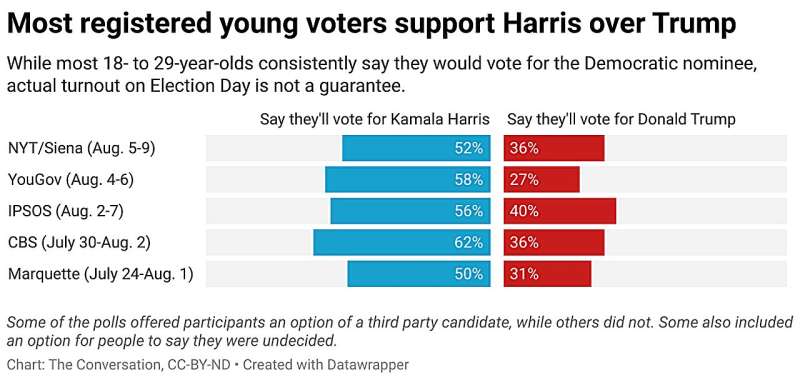Ram Mandir in the NYC India Day Parade is a symbol of hate, not heritage
As Indian Americans become more visible in politics and public life, there is a growing need to reflect on the kind of legacy we are building.

A general view of the audience during the opening of the Ram Mandir, a temple dedicated to Hindu deity Lord Ram, in Ayodhya, India, Jan. 22, 2024.
August 16, 2024
By Sunita Viswanath
(RNS) — This year’s India Day Parade in New York City on Sunday (Aug. 18), traditionally a celebration of India’s vibrant democracy and cultural diversity, will be marred with a float of a model Ram Mandir, the controversial temple to Lord Rama in Ayodhya, India. Organizers who included the float insist this is an expression of Hindu heritage in India, but this structure signals a divisive ideology that threatens the very values the parade seeks to celebrate.
India’s Ram Mandir stands on the site of the Babri Masjid, a centuries-old mosque that was illegally demolished in 1992 by a mob of Hindu extremists, sparking Hindu-Muslim riots that killed at least 2,000 people, mostly Muslims. This violence was the culmination of a campaign based on the unproven claim that the mosque stood on the birthplace of the Hindu deity Ram — a claim rejected by historians, the Archaeological Survey of India and, until recently, the Indian judiciary.
The ruling Bharatiya Janata Party, which has promoted an increasingly authoritarian agenda in India, has recently faced setbacks, but the ideology of Hindutva — a Hindu nationalist movement — remains a potent and destructive force. This ideology’s threat to Indian society, particularly on Muslims and Christians, is profound and ongoing.
In the U.S., as Indian Americans become more visible in politics and public life, there is a growing need to reflect on the kind of legacy we are building. Our community must mature and take responsibility for the messages conveyed at events like the India Day Parade. The inclusion of the Ram Mandir float is not just a cultural statement. It’s a troubling emblem of exclusion and intolerance.
This marks a continuation of a disturbing trend that began in 2022 when the India Day Parade in Edison, New Jersey, featured a bulldozer — a symbol of the brutal tactics used by India’s current regime to demolish homes and lives, particularly those of Muslims. For many Americans, the inclusion of such symbols in a celebration of Indian heritage might seem perplexing. But this is more than just an internal issue for the Indian community; it’s an alarm for how dangerous ideologies can cross borders and influence communities far from their origins.
RELATED: A celebrated temple in India is also a symbol of the country’s anti-Muslim campaign

Awadhesh Prasad, center, is blessed by Swami Ram Das and other Hindu clerics at Sidh Peeth Mandir in Ayodhya, India, on June 5, 2024, the day after Indian elections. (Courtesy photo)
Yet, there are signs of hope that the days of Hindutva rule may be numbered. In a surprising turn of events, a BJP parliamentarian was recently unseated in Ayodhya, the very city where the Ram Mandir stands, replaced by Awadhesh Prasad of the socialist Samajwadi Party. Despite its predominantly Hindu population, Ayodhya chose to reject Hindu nationalism in favor of a Dalit candidate, signaling a desire for a more inclusive and compassionate vision of Hinduism. Prasad has spoken in the press as a devotee of Lord Ram: “No one can be a greater devotee of Ram than me. I am a native of Ayodhya, so who could be closer to Lord Ram than me?”
Swami Ram Das, the mahant (temple chief) of Sidh Peeth Mandir in Ayodhya, was among those who supported Prasad, even offering him his blessing along with other local Hindu religious leaders. Their cooperation sent a message that resonates far beyond India’s borders.
Speaking to me after the election, Swami Ram Das said: “Ayodhya is the land of Lord Rama, the supreme deity who accepts all people, especially marginalized people, and people of all religions and cultures. Real Hinduism teaches us love, unity and respect for other beliefs. Rama doesn’t belong to one person, one party or one religion. He exists in all of us.”
Swami Ram Das further highlighted the irony that despite the grand inauguration of the Ram Mandir being livestreamed in Times Square, he and most Ayodhya-based religious leaders were not invited. Laughing, he told me: “Why do I need to go? Ram is in my heart.”
RELATED: India’s Hindu nationalism is exporting its Islamophobia
The people of Ayodhya voted out the BJP and its divisive Hindutva politics. Instead, they embraced the inclusive Hindu faith that Swami Ram Das represents. New Yorkers can do the same.
The dangerous ideology that the Ram Mandir float represents has no place in a city known for being a refuge for the persecuted and marginalized. After all, the same Hindu nationalist regime that promoted the Ram Mandir has been credibly accused of assassinating its critics outside of India, including attempting to kill a New Yorker.
New York City, which proudly stood as a sanctuary during former President Donald Trump’s Muslim travel ban, must reaffirm its commitment to combating hate and Islamophobia. The Ram Mandir float in the New York parade is not a symbol of heritage. It is a symbol of hate. Indian Americans must ensure that our cultural expressions in public spaces reflect the diversity, inclusivity and democratic values central to both our Indian and American identities.
(Sunita Viswanath is the executive director of Hindus for Human Rights. The views expressed in this commentary do not necessarily reflect those of Religion News Service.)

FILE - Participants march during the India Day Parade on Madison Ave. Sunday, Aug. 19, 2018, in New York. (AP Photo/Craig Ruttle, File)
By Richa Karmarkar
NEW YORK (RNS) — This year’s India Day parade in New York City, a long-running celebration of the birth of Indian democracy and the diversity of the diaspora, has stirred dissent for its plans to prominently feature a float of the Hindu deity Ram and a model of a controversial temple recently built over a demolished mosque.
The parade, to take place Sunday (Aug. 18), is the largest of its kind outside India. Grand marshals, usually A-list Bollywood celebrities, lead hundreds of marchers with fanfare through Manhattan’s tree-lined Madison Avenue. This year’s theme is “Vasudhaiva Katumbakum,” a Sanskrit phrase translating to “the world is one family.”
“We celebrate our unity in diversity, and we celebrate inclusiveness — that’s our India,” said Avinash Gupta, the president of the parade’s organizer, the Federation of Indian Associations.
Gupta said the parade is meant to honor all Indians from diverse regional, linguistic and religious backgrounds, to recognize their freedom from British rule 78 years ago and also to celebrate “how well the Indian diaspora has done here in the fields of science, technology and now politics.”
A Hindu, Gupta hoisted India’s tri-color flag in Times Square on Thursday (Aug. 15), Indian Independence Day, to celebrate next to his “Muslim, Sikh and Christian brothers,” he said.
But this year’s centerpiece float featuring an 18-foot-long, 9-foot-wide and 8-foot-tall statue of Lord Ram and a replica of the recently opened Ram Mandir (temple) in Ayodhya, India, has sparked fierce criticism from those who say the float represents anti-Muslim sentiments while misrepresenting Indian and Hindu values.
RELATED: Ram Mandir in the NYC India Day Parade is a symbol of hate, not heritage
The temple to Ram was opened early this year and built after a Hindu extremist mob demolished a 16th-century mosque on that site in 1992, believing the contested claim that the Mughal emperor Babur constructed the mosque on the exact birthplace of Lord Ram. The deadly Hindu-Muslim riots that followed killed over 2,000 people across the country, mainly Muslims.

A general view of the audience during the opening of the Ram Mandir, a temple dedicated to Hindu deity Lord Ram, in Ayodhya, India, Jan. 22, 2024. (AP Photo/Rajesh Kumar Singh)
After many disputes, India’s top court finally ruled in 2019 that a new temple dedicated to Ram could be built on the site.
While many devotees see the newly opened mandir as an overdue homecoming of baby Ram and a rejection of Islamic conquest, some others see the temple itself as a symbol of Hindu exclusivism and are reminded of the painful rift it exasperated between the two communities.
“The inclusion of the Ram Mandir float in this year’s parade is not a celebration of cultural pride, but a glorification of both a violent history and a violent ambition,” said David Kalal, communications director for the progressive organization Hindus for Human Rights, speaking at a press conference. “Given the growing political activity and influence of Indian Americans, the debates within our community have broader implications for American society as a whole.”
On Wednesday (Aug. 14), representatives from several faith-based groups, including Hindus for Human Rights, the Indian American Muslim Council, the Council on American-Islamic Relations and the New York State Council of Churches, held a press conference outside of City Hall to condemn the float and to call for its prompt removal.
More than 20 groups signed a letter to Mayor Eric Adams and Governor Kathy Hochul, arguing that the sponsors of the float, the Hindu nationalist organization Vishwa Hindu Parishad of America and the Hindu denomination BAPS Swaminarayan Sanstha, plan to use the parade to “propagate hate and instill fear among American Muslims.”
“If there is a float or a person in the parade that is promoting hate, they should not,” Adams said on Wednesday.
The Hindu American Foundation, the largest advocacy organization for Hindus in the U.S., sent a letter today (Aug. 16) urging Adams to “support freedom of expression” and the inclusion of the float, arguing common narratives about the mosque dispute miss historical context.
According to Gupta, no city officials or law enforcement agents have reached out to FIA to remove the float.
To Gupta, the float is nothing more than a prideful tribute to the temple.
“There are a lot of people here who cannot go to India to visit the temple because of their age, because they have medical conditions, or they simply cannot afford to go, so this will be a good opportunity for them to see the replica of the mandir, which was built after a 500-year wait,” Gupta said.
While the Ram float will not be taken down, Gupta doesn’t want it to represent the parade as a whole, which he said includes floats from Muslim, Sikh and Christian Indian organizations. Instead, he hopes non-Indians see the parade as a celebration of the diaspora’s rising power, now more than 5.4 million strong.
“I feel very proud that we collect, we gather, we bring together all of the Indian diaspora, of all states, all faiths, all religions, and we march together,” Gupta said. “We all have to be united, and that way, we’ll have our voice heard.”
The Rev. Chloe Breyer of the Interfaith Center of New York, a longstanding institution that partners with faith groups throughout the city, said she approaches the complicated situation with an acknowledgement of “the deep ties between Hindu New Yorkers and the sacred geography of India,” and an affirmation of the group’s right to religious freedom.
But instead of religious freedom, she said, the float seems more like “religious boasting that is definitely viewed as the opposite of what they’re proud of.” In a statement released on Aug. 12, Breyer and ICNY cautioned the organizers to be more mindful of current religious relations in the U.S. and abroad.
“That question of this contested site is not one that a press conference is going to solve, and it’s not one I’m going to solve,” she said. “However, if you’re in New York City and you’re having a parade to celebrate your heritage, I would just say, know your people and know your context. Your neighbors are some Hindus and some not Hindus.”
RELATED: In India’s new Ram temple, some American Hindus see a new beginning
Uma Mysorekar, president of the Hindu Temple Society of North America in Flushing, Queens, an ICNY partner, says the controversy is painting Hindus as intolerant, which she feels contradicts the purpose of an Independence Day parade. Describing herself as a “very religious person,” Mysorekar said she understands why this float would be a source of pride for many Hindu Americans.
But the timing of the float, she said, is like “adding more fuel to the fire,” given that the temple came “only less than a year ago,” and that there are “so many other ways” to symbolize India’s vast and beautiful diversity. In private conversations, she said, many Hindus going to the parade agree with her sentiment.
“Indian Independence Day has nothing to do with religion,” Mysorekar said. “Independent India consists of all kinds of people, and we represent the beliefs and thoughts of everybody. … I think we must respect that and uphold India’s integrity. That’s really important.”











